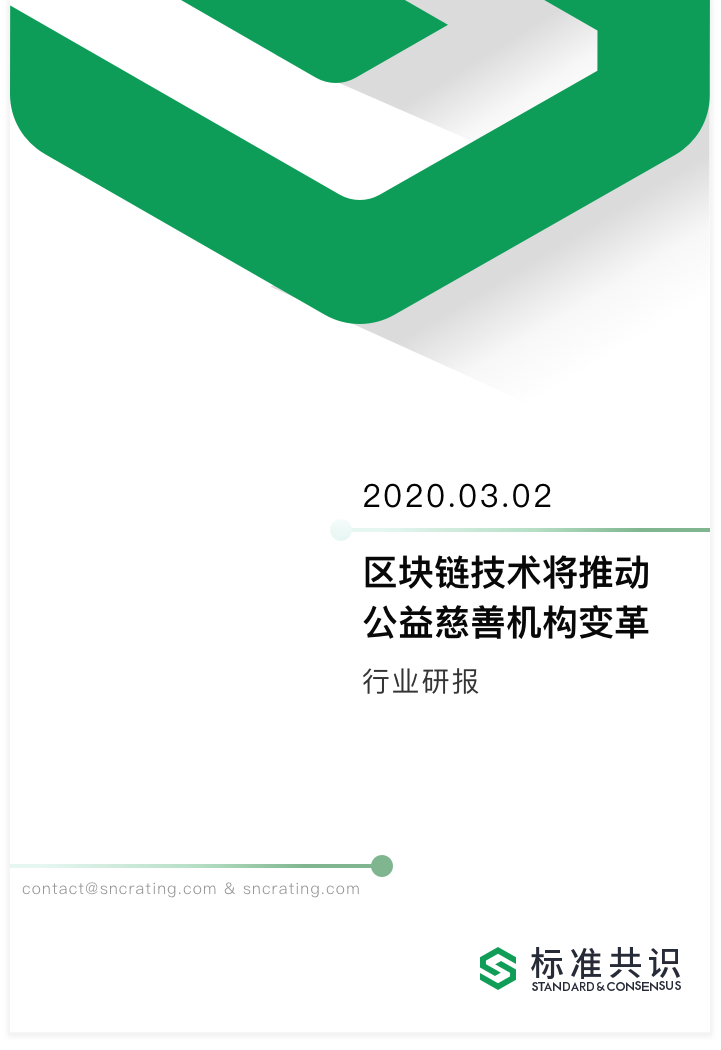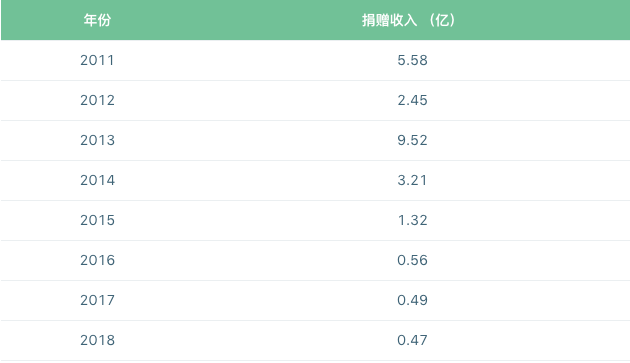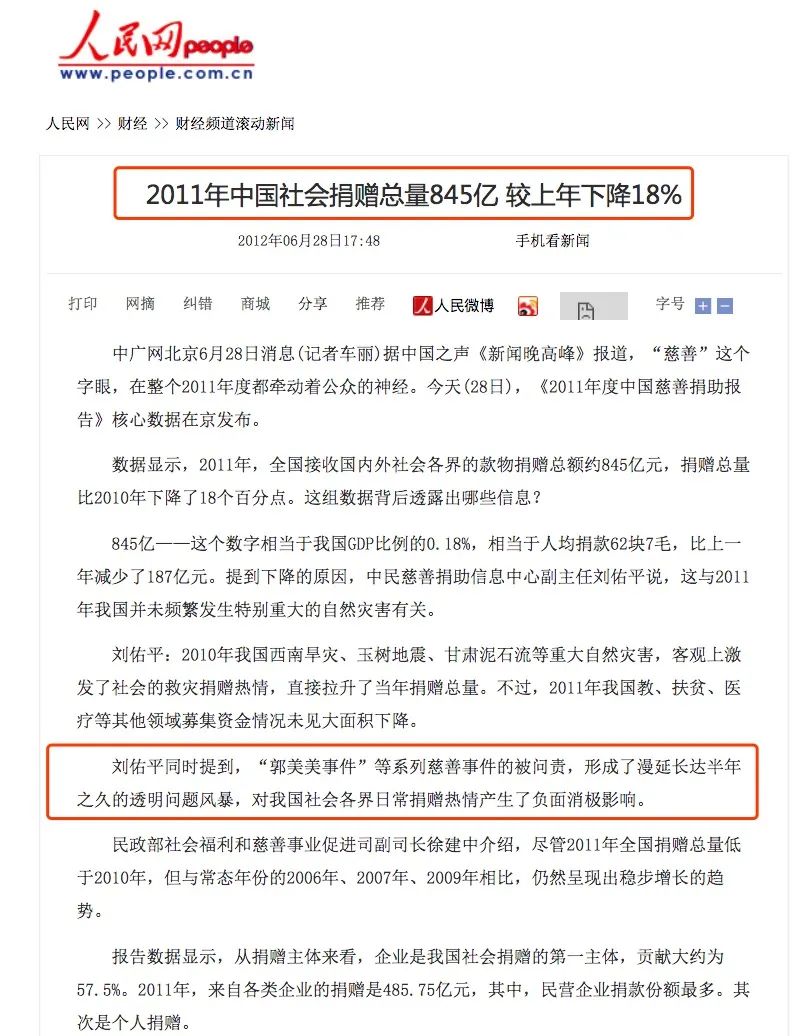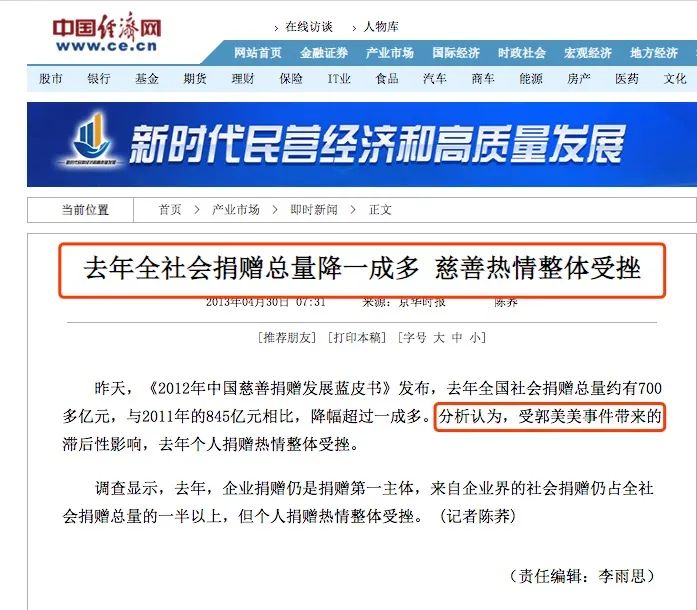Research | How Does Blockchain Technology Promote the Transformation of Charities?

Overview
Public welfare and charitable organizations have repeatedly produced trust crises, causing serious consequences and creating a vicious circle. In this article, we discuss the use of blockchain consensus mechanism and token mechanism to solve this problem. This scheme introduces restrictive relationships to protect the interests of all parties involved (including institutions and the public), uses a token mechanism to isolate asset management and operational management, and guarantees the safe and effective use of good money through multi-signature and token exchange.
Report
China's Charity Market Status
In recent years, China's charitable organizations have developed rapidly. According to the data in the charity blue book released in 2019, as of the end of 2018, the total number of social organizations nationwide was 816,000, an increase of 7.1% compared to 2017, and the total value of social charities reached 3265.2 100 million yuan. However, due to the difficulties of high entry barriers and low management efficiency in China's charity units. Some charitable organizations suffer from poor management and improper funding. Especially in recent years, especially in recent days, the negative information of charitable organizations has continuously emerged, causing the public to question charitable organizations widely. And it has led charities to an unprecedented crisis of trust.
The actual social donation in 2016 was 145.8 billion yuan, and the actual social donation in 2017 was 152.6 billion yuan. China's total social donations in 2018 are estimated to be about 112.8 billion yuan, down 26.1% from 2017. Despite the significant increase in social donations, 43.5% of volunteer organizations still face insufficient funding for volunteer services.
- deal! Germany officially classifies digital assets as financial instruments and does not have monetary legal status
- Tokenized securities say it's easy, but CBDC is in trouble? What does the latest BIS report say
- February security incident inventory: 12 incidents lost a total of 48.23 million US dollars, bZx was attacked by hackers
With the continuous development of philanthropy, China's existing laws and regulations on charitable organizations show various deficiencies. It was not until September 1, 2016 that China formally promulgated the Charity Law. Compared with the United Kingdom and the United States, which enacted the Charitable Trust Act and the Entertainment Charity Act in 1954 and 1958 and continued to improve the charity law in the 21st century, the Law on Promotion of Certain Nonprofit Activities was promulgated in 1998 and began in 2008 Japan, which has implemented a new public interest corporation system, has fallen behind by more than ten years.
In China's existing charity management, problems such as inadequate external supervision and inadequate internal governance mechanisms can be seen everywhere, and charitable organizations have shown many deficiencies in information disclosure. Information disclosure, as the main way for the public to understand the operation and management process of charitable organizations, is currently difficult to meet the regulatory needs and voices of the society. Eventually, it leads to the loss of confidence of the public in public charity. problem.
Charity status
According to the status of domestic charitable organizations, several existing non-profit organizations in China can be divided into three types: grassroots non-profit organizations, undefined non-profit organizations, and statutory non-profit organizations. The so-called grassroots non-profit organizations refer to some non-profit non-profit organizations that have not been formally accepted and recognized. They do not have a certain legal status, and their activities are spontaneous, and they have not been registered. Untyped non-profit organizations refer to some social organizations that are undergoing transformation and are new or other types. The more classic ones are network groups and institutions in transition. Statutory non-profit organizations are social organizations that register through regular means and carry out various activities in accordance with laws and regulations. They also include some organizations that are exempt from civil registration but have legal status.
As of the end of 2018, the total number of social organizations nationwide was 816,000, an increase of 7.1% compared to 2017, and the growth rate declined. Among them, there were 7,027 foundations, 366,000 social groups, and 443,000 social service organizations, respectively. In 2017, it increased by 11.4%, 3.1%, and 10.8%. According to statistics from the Foundation's central network, as of December 31, 2018, the total number of national foundations was 7015, an increase of 631 from 6,384 in 2017, with an annual growth rate of 9.8%.
A crisis of trust is key and leads to further deterioration
With the rapid development of China's economy and society, the difficulty of public governance continues to increase. Charitable organizations have unique and important advantages in participating in social governance and extending government functions. They can even play a role in filling the "vacuum" of government functions in certain periods. In our country, the administrative management of charitable organizations had a problem of double-headed administration. The registration management was attributed to the civil affairs department, but the business management was not vested in the civil affairs department, but was borne by other government functional departments. As a result, in practice, the responsibility for supervision is unclear. At the same time, due to the absence of law, information disclosure is not a statutory obligation of government supervision.
The lack of effective supervision of charitable organizations, the lack of legal status of non-governmental charitable organizations, and opaque information are important issues facing domestic charitable organizations. They have collectively led to a crisis of trust in charitable organizations.
How severe is the "distrust"? We use various data after the "Guo ** Incident" in 2011 to explain. Based on the core data of the 2011 China Charity Donation Report. The institutions most affected by Guo Meimei, the system received about 2.867 billion yuan in social donations in 2011, a decrease of about 59% compared to 2010. In contrast to the sharp drop in donations received by the institution, in 2011, China's total social donations totaled approximately 84.5 billion yuan, and the total donations fell by 18.1% compared with 2010. The chain reaction formed by the incident has not ended, and it will continue to look at 2012. In the "Blue Book on the Development of China's Charitable Donations in 2012", the total amount of social donations across the country is about 70 billion yuan, a decrease of about 17% compared with the 84.5 billion yuan in 2011. Looking at the public annual audit report data of the most affected organization, the numbers tell the whole story. The donation income is as follows:

2011 People's Daily News

China Economic Net News 2012 
Even more dangerous is that the crisis of trust has begun to lead to an increase in the crisis of trust.
Starting from distrust, a series of logical evolutions will lead to a more vicious cycle. Don't trust->…-> more distrust. For example: Do not trust-> Cope with more doubts-> Less energy to handle donations-> Solve incidents worse-> Do not trust mistrust-> Donation amount is less-> Difficult areas are more difficult to get help-> Regional development is slower -> More people in need-> Affecting overall economic development-> Less donations-> More distrust There are many similar logical evolutions …
Lack of effective oversight of charities
The "Guo ** Incident", "China-Africa Greek Project", "Still Fraudulent Donation", "Song * ling Stone Statue", "4 * Catty Girl" and various types and their incidents have been questioned by the public and seem to be charged for management Fees and invoicing have become a profitable act. Every year, high management fees are put into the pockets of managers. Because of their official origin, external supervision is not well-known for their supervision. The public can only supervise them by appealing to public opinion, but often such articles cannot be retained. Too long. As an external supervisor, the government failed to implement effective supervision, but directly participated in the daily operations of charitable organizations administratively.
We can peep at the government's measures after recent events. This "being an athlete and referee" approach has increased the difficulty of supervision. Official background charities rely on the authority and credibility of the government to obtain resources and carry out operational activities, but administrative supervision cannot effectively manage them. In the end, when a crisis event of trust occurs, the credibility of the government is lost.
Private charities lack legal status
The credibility of charitable organizations is mainly composed of legitimacy. Endorsement by law is the most effective way to quickly gain public trust. Legitimacy means public support in accordance with accepted traditions and norms. Charitable organizations must obtain a certain legal status in order to obtain public recognition. Obtaining public recognition is the most important way to obtain social resources. Under this consensus, private charitable organizations have a natural need to obtain legal status. However, in fact, the ambiguous relationship between private charitable organizations, private non-enterprise units and foundations, the uncertainty of the regulator, and the vagueness of the nature of the determination cannot win public trust. Statistics show that more than 80% of China's private charitable organizations are "illegal existence".
One Fund is a typical example. This private equity fund, which officially operated in Beijing in 2007, is linked to other institutions, and can use its name to raise funds publicly. However, due to legal reasons, it was in danger of being interrupted. The One Foundation, which is attached to the name of the Red Foundation, does not have legal personality and has no official seal, so it has very limited restrictions on deep-level cooperation with the enterprise and the transfer of funds. After the Wenchuan earthquake, One Foundation tried to allocate 4 million yuan from the charity funds for post-disaster reconstruction processing. However, due to the need for those funds to go through a series of complex approval processes, 4 million yuan was still used after being transferred from Beijing to Sichuan. No, in the end they returned to Beijing. In the end, while the One Fund had to wait for the fundraising to go through the process, the team first contributed funds in advance in the name of an individual to carry out the preliminary disaster relief work.
On the other hand, the law sets too high a threshold for the legalization of the identity of non-governmental charitable organizations, and some legalized non-governmental charitable organizations have beckoned under the guise of charity. After the Yanran Angel Fund was established, the first task was to find a suitable designated hospital and cooperate to complete the rescue of children with cleft lip and palate. However, in the early days of the charity foundation, Li Yapeng put forward "three conditions" to the hospital. Most public hospitals have difficulty accepting these requirements. Li Yapeng is completely in a weak position with public hospitals and has little chance of winning. Under pressure, Li Yapeng can only choose private hospitals as partners. As another example, Han Hong's foundation has actively donated money and materials since the Wenchuan earthquake. The Han Hong Love Charity Foundation was established in 2012, but it did not get legal public fundraising qualifications until 2019.
Over time, private charity has also ushered in a certain degree of favorable policies. The cumbersome process of the foundation was finally eased after the enactment of the "Charity Law of the People's Republic of China" in 2016. The passage of the charity law provided new fundraising channels for non-public foundations, and also provided optimized support for charitable organizations. The issue of legalization of the organization has been alleviated to some extent.
Information is not transparent
In recent years, although the transparency index of Chinese charities has improved year by year, most charities still fail to provide some key and sensitive information, such as remuneration of principals and managers, and audited financial statements of charitable projects. .
Even if there is such a centralized Internet-based information publishing platform, it does not mean that it is the best channel for charity organizations to disclose information. The original texts of various information reports were not readily available in a timely and convenient manner. The websites of some charitable organizations still have incomplete information disclosure, timeliness, and the information disclosed cannot be verified.
Wu Wenhu, a professor of communication at Jinan University, said, "In a society where class divides exist and monopolistic groups rely on privileges to realize their desires, the sense of deprivation of the bottom groups can easily be expanded and exacerbated. Sensitive people quickly form collective distrust. The more opaque the system and position, the easier it is to become a gunpowder that provokes public grievances. "
How to gain credibility
So how can charities regain credibility? To solve this problem, we must first understand the generation mechanism of credibility. A professor of sociology at the University of California, Los Angeles (UCLA), which the author highly respects, wrote in his thesis "Production Trust: The Institutional Basis of Economic Structure": Trust comes from the process of communication, from organizational characteristics, and from the legal system.
He believes that the historical reputation of both parties will give trust to each other, and that two parties with similar societies will easily build trust. The legal system provides protection for human behavior and can also generate trust.
First, in terms of the credibility of charitable organizations, charitable organizations with a good history and reputation can easily gain public trust. There are two main reasons for the public to judge the reputation of charitable organizations: 1. From the first-hand information proactively released by charitable organizations. 2. Second-hand information from public opinion. Both affect public trust in charitable organizations.
For example, many charitable organizations invite donors to participate in project inspections in order to give donors first-hand information. In the history of continuous interaction and interaction between charities and donors, both parties can quickly build trust through positive feedback. At the same time, media, self-media and experts play a key role in second-hand information. The accumulation of information obtained by the public through these channels will form a judgment on this charity. Charitable organizations that play a positive role in the media often gain public trust.
In order for charitable organizations to gain the trust of the public, they must try their best to make the public obtain authentic, authoritative and reliable information from inside and outside the charitable organization. However, the way in which information is transmitted determines whether the true information of the charity can reach the public, and thus determines the degree of public trust in the charity. Because there are omissions and distortions in the process of information transmission, and the more information transmission links, the more information is omitted, so first-hand information and second-hand information have different effects on the credibility of charitable organizations. For the general public, they rarely rely on first-hand information, most rely on second-hand information to determine whether to give trust, and the information that the public refuses to give trust is mainly second-hand.
Second, people determine whether a charitable organization is credible based on certain social characteristics. The more similar the values of the public and the charity, the more the charity meets the expectations of the public, the more the public will trust the charity.
Trust and expectations are linked. The greater the trust, the higher the expectations of the trusted person; the smaller the trust, the lower the expectations of the trusted person. People's long-term expectations for a social role will be solidified into the role's behavior rules. If the role does not meet everyone's expectations, it will be considered dishonest and will be punished accordingly. Even if everyone's expectations for the role are unreasonable, the character will be punished for failing to meet expectations. If the behavior of the trustee meets or exceeds the expectations of the trustee, the relationship between the two parties will be consolidated or strengthened, and the trustee will continue to give the trustee trust in the future. Charitable organizations need to understand what the public expects of them. Donors entrust valuable funds to charitable organizations, and at the same time give charitable organizations good expectations of donated funds and materials.
Third, the law provides strong and compulsory guarantees for both parties, and those who break faith will be punished by the law. As a result, when the law implements its duties, the public will trust the charity more.
The "Charity Law" introduced in 2016 solved the problem of "unreliable" in the charity industry. However, due to historical reasons, the issue of "strict enforcement of law" that the public expects is still being implemented. Public dissatisfaction with the enforcement of the law. When charitable organizations are unable to respond to the public's reasonable expectations, or even intentionally do evil, they can be punished according to law, which will not only improve the credibility of charitable organizations, increase the cost of breaking the law, but also the credibility of government departments.
Therefore, gaining credibility requires the introduction of restrictive mechanisms (regulations, participants, etc.), ensuring information disclosure, and meeting public expectations.
Discussion on Blockchain Solutions
The essence of the blockchain is to resolve the fact that transactions can still be conducted with each other under conditions of distrust. In the field of public welfare and charity, the blockchain consensus mechanism and technical means can be used to achieve the above-mentioned solution "introduce restriction mechanisms (regulations, participants, etc.), ensure information disclosure, and meet public expectations. Simply solving superficial problems such as information transparency and legislation cannot solve the problem of trust. This solution is a "headache, foot pain, foot cure" approach. The essential problem remains unsolved, and a crisis of trust will inevitably occur.
Transparent and open data is not the key to the problem. It can be said that any public welfare charity has a corresponding information system that publicizes various types of information, but the problem of trust still exists, and it has broken out again in the near future. Obviously, the construction of information technology or information system is much better in 2019 than in 2011. Has the problem been solved? Laws and regulations are not enough to solve the problem. As mentioned above, there was no charity law in the 2011 “Guo Meimei Incident”, but on September 1, 2016, China officially released the charity law. As of 2019, the crisis of trust has once again erupted. Has the problem been solved?
For a blockchain solution to be effective, it should be as described earlier: "Introduce constraints (regulations, participants, etc.), ensure information disclosure, and meet public expectations." What this blockchain solution looks like, our vision is as follows:
- The blockchain's POS consensus mechanism is used to make regulators, large donors, asset custodians, etc. become super nodes, and the single jurisdiction of the public welfare charity has become a node consensus voting mechanism. This will make the main participants a common interest group, and the interests of this group are in line with the public interest. The consensus mechanism guarantees that the interests are consistent and cannot harm other participants (or it will cost so much that it is not feasible);
- The management of public welfare organizations is separated from the management of funds, and the token exchange model is adopted to eliminate black box operations and improve operational efficiency. The recipient receives the tokens allocated by the public welfare organization, and the asset custody institution transfers the funds to the bank account of the recipient according to the token holding status of the recipient. The blockchain will ensure that funds are transferred transparently, traceably, and can be exchanged in real time;
- Multi-signature technology is used to ensure the effective management of tokens and corresponding funds. The transfer of tokens should be signed by asset custodians, public welfare organizations, and large donors.
Problems that blockchain can solve
The birth of blockchain technology reduces the cost of reducing trust, because it is essentially a distributed ledger that can perfectly solve the trust crisis in information systems. The main problems and countermeasures are as follows:
- Problem: The use of funds is not restricted: POS multi-signature makes the default cost extremely high through the consensus mechanism and multi-signature mechanism
- Problem: opaque capital flow solution: data on-chain
- Problem: Inefficient use of funds, materials, etc.Solution: Smart contract digital asset allocation
Blockchain solution system framework
The blockchain uses the POS consensus mechanism and a limited participation alliance chain. Large donors, public welfare agencies, regulatory agencies, and asset custody agencies are all supernodes. The operation management and asset management of non-profit organizations are separated through the token system of the blockchain itself, and asset custodians issue tokens to recipients. The recipient uses the token exchange mechanism to exchange funds with the bank.

Description
The blockchain uses mechanisms such as decentralization, asymmetric encryption, and distributed storage to ensure that all nodes in the system can automatically and securely exchange data in a trusted environment, and this mechanism saves time and money, can automatically match, Enforcement has advantages over other time-consuming and labor-intensive tools.
Since Bitcoin, blockchain technology has continued to develop. In 2014, Ethereum further derived a smart contract technology with a variety of new functions. The smart contracts were written into the blockchain in a digital form. The characteristics of technology ensure that the entire process of storage, reading, and execution is transparent, traceable, and unchangeable. It can solve the problem of trust among individuals, between individuals and organizations, and between people and the Internet of Things.
Because humans are fickle and complex species, and humans always make mistakes, and blockchain technology is an intelligent trust that cannot be tampered with. Humans may violate regulations to falsify, but technology will not deceive the public.
Under the influence of technological developments such as the Internet, big data, and blockchain, the public will increasingly appreciate the importance of credit, because once a contract is breached, it means that everyone can know the public's untrustworthy behavior at the same time. It directly affects the public's use of these credit services in the future, and will to some extent promote users to cherish their credit more and more, thereby enhancing the trust between people in the entire society.
Conclusion
This article can only technically propose a solution that together provides a feasible means for charity organization information disclosure, self-regulation and external supervision, but its implementation still faces difficulties. Therefore, while thinking about the reasons for the problem and proposing a solution, the problems in this article still have problems such as lack of understanding of laws and regulations, content details, and insufficient understanding of the true operating procedures of charitable institutions' electronic systems. With the deepening of the investigation, These remaining issues will be presented as further discussion in the future.
risk warning:
- Beware of illegal financial activities under the banner of blockchain and new technologies. The standard consensus firmly resists the use of blockchain for illegal fundraising, online pyramid schemes, ICOs, various variants, and dissemination of bad information.
We will continue to update Blocking; if you have any questions or suggestions, please contact us!
Was this article helpful?
93 out of 132 found this helpful
Related articles
- Dry Goods | Read the Taproot / Schnorr Upgrade for Bitcoin
- DeFi guardian: DeFi insurance agreement
- DeFi weekly selection 丨 Lightning attack or new normal, should I buy insurance for DeFi?
- Web3 Foundation announces funding for Second State blockchain company, introduces Ethereum virtual machine to Boca ecosystem
- Popular Science | Eth2 Beacon Chain: What You Should Know First (2)
- Why does Babbitt's weekly quotation suddenly disappear? Can the Bitcoin halving effect be fulfilled again?
- UAV plant protection, multispectral imaging, blockchain technology, farmer's uncle's farming "black technology"





